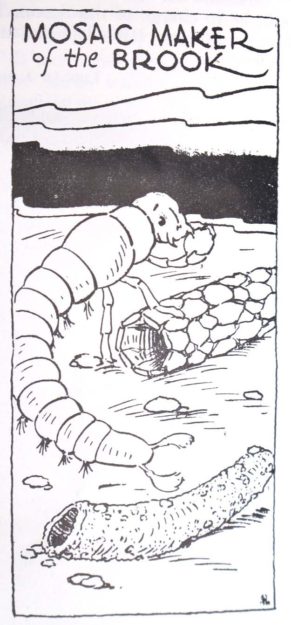Ellsworth Jaeger, « Follow the Explorer’s Trail », Hobbies, The Magazine of The Buffalo Museum of Science, vol. 36, n° 5 , juin, Buffalo, Buffalo Society of Natural Sciences, 1956, p.96.
 One of the strangest of mosaic art is made in the brooks and streams of our neighborhood. Here on the sand or mud of the bottom, tiny tubular cases can be discovered. Some are made of carefully selected minute pebbles jointed edge to edge and cemented with a substance only know to the tiny maker. One end of the tube is usually closed with a larger pebble, just right size of the opening.
One of the strangest of mosaic art is made in the brooks and streams of our neighborhood. Here on the sand or mud of the bottom, tiny tubular cases can be discovered. Some are made of carefully selected minute pebbles jointed edge to edge and cemented with a substance only know to the tiny maker. One end of the tube is usually closed with a larger pebble, just right size of the opening.
This is the stone cottage of the caddis babies, the adults of which we can find attracted by the lights of evening. Each caddis family, however, seems to have its particular choice in building materials for these tubular cases. Some use pebbles or grains of sand, others seem to have a special preference for tiny sticks and stems. Another family may select only tubular pieces of floating grass and straws.
Since caddis larva is on the bill of fare of the fish, he has developed this protecting tube to house his soft body. Thus safely entrenched in his mosaic armor, he watches the stream of life go by.